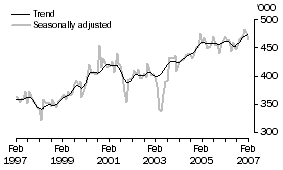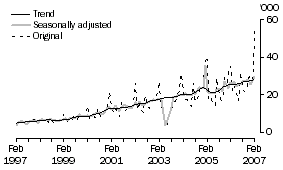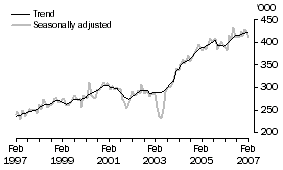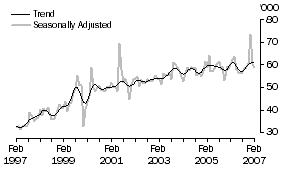MAIN FEATURES
SHORT-TERM VISITOR ARRIVALS
In trend terms, short-term visitor arrivals to Australia in February 2007 (472,900 movements) were marginally higher than in January 2007 (472,400 movements). Short-term visitor arrivals are currently 4.5% higher than when the series last troughed in July 2006 (452,500 movements) and 2.4% higher than in February 2006 (461,900 movements).
SHORT-TERM VISITOR ARRIVALS

The following table presents the top ten source countries (based on original estimates) for short-term visitor arrivals during February 2007. Seasonally adjusted and trend estimates are also presented for these countries, along with the percentage change in trend compared with January 2007 and February 2006.
Short-term Visitor Arrivals, Major Source Countries - February 2007 |
|  |
 | Trend | Seasonally
Adjusted | Original | Jan 07 to
Feb 07 | Feb 06 to
Feb 07 |  |
 | '000 | '000 | '000 | Trend % change | Trend % change |  |
|  |
| United Kingdom | 61.0 | 58.8 | 77.3 | 0.1 | 1.3 |  |
| New Zealand | 96.2 | 93.9 | 64.3 | 1.3 | 6.0 |  |
| Japan | 51.2 | 51.7 | 55.3 | -1.4 | -9.0 |  |
| China | 28.0 | 29.9 | 54.0 | 0.8 | 8.4 |  |
| United States of America | 37.8 | 37.2 | 42.9 | -0.2 | -1.9 |  |
| Singapore | 22.0 | 20.7 | 22.7 | -0.2 | 3.7 |  |
| Korea | 21.3 | 18.8 | 19.8 | -3.6 | 6.3 |  |
| Hong Kong | 12.3 | 11.6 | 17.9 | -1.0 | -9.6 |  |
| Malaysia | 14.0 | 13.6 | 17.1 | 1.4 | 5.9 |  |
| Germany | 12.5 | 12.7 | 16.5 | 0.5 | -1.4 |  |
|  |
Short-term visitor arrivals from China
Original estimates for short-term visitor arrivals from China in February 2007 reached 54,000 movements, the highest number of movements recorded during the past ten years. This peak is related to Chinese New Year which was celebrated on 18 February 2007. The seasonally adjusted series for China has been estimated taking this regular calendar event into account. For further information see paragraph 23 of the Explanatory Notes.
The graph below shows two outliers for the seasonally adjusted series for short-term visitor arrivals from China. The first outlier shows the decrease in the visitor arrivals series in mid-2003 coinciding with the outbreak of Severe Acute Respiratory Syndrome (SARS). The reason for the second outlier, in January 2005, is less clear, but the series increased following the Indian Ocean earthquakes and tsunami that occurred on 26 December 2005. Many travellers from China who would have travelled to regions affected by the earthquakes and tsunami may have chosen Australia as an alternate destination. In both cases these outliers were not influenced by Chinese New Year travel.
CHINA, Short-term Visitor Arrivals

SHORT-TERM RESIDENT DEPARTURES
In trend terms, short-term resident departures from Australia in February 2007 (420,200 movements) were marginally lower than in January 2007 (420,500 movements). Short-term resident departures are currently 6.9% higher than in February 2006.
SHORT-TERM RESIDENT DEPARTURES

The following table presents the top ten destinations (based on original estimates) for short-term resident departures during February 2007. Seasonally adjusted and trend estimates are also presented for these countries, along with the percentage change in trend compared with January 2007 and February 2006.
Short-term Resident Departures, Major Destinations - February 2007 |
|  |
 | Trend | Seasonally
Adjusted | Original | Jan 06 to
Feb 07 | Feb 06 to
Feb 07 |  |
 | '000 | '000 | '000 | Trend % change | Trend % change |  |
|  |
| New Zealand | 73.5 | 75.0 | 75.9 | -0.4 | 5.6 |  |
| United States of America | 37.1 | 38.4 | 25.6 | 1.2 | 1.0 |  |
| Thailand | 28.9 | 27.6 | 22.5 | 3.2 | 29.6 |  |
| United Kingdom | 32.2 | 30.8 | 16.0 | -1.6 | 1.7 |  |
| Indonesia | 23.0 | 21.3 | 13.9 | 5.3 | 44.0 |  |
| Singapore | 16.5 | 16.3 | 13.5 | -0.7 | -3.6 |  |
| Malaysia | 15.2 | 15.8 | 13.1 | 2.0 | 6.2 |  |
| China | 20.0 | 19.2 | 13.1 | -2.2 | 4.6 |  |
| India | 10.2 | 9.1 | 11.7 | 2.7 | 23.0 |  |
| Hong Kong | 14.6 | 13.2 | 11.7 | -4.9 | -6.8 |  |
|  |
PERMANENT AND LONG-TERM MOVEMENTS
There were 11,040 permanent (settler) arrivals to Australia during February 2007, an increase of 0.8% compared with February 2006 (10,960 movements). People born in New Zealand accounted for the largest proportion of settlers (20%), followed by people born in the United Kingdom (15%), India (10%) and China (9%).
There were 5,390 Australian residents departing permanently from Australia during February 2007, an increase of 6.3% compared with February 2006 (5,060 movements).
Statistics on overseas arrivals and departures relate to the number of movements of travellers rather than the number of travellers. Care should be taken when using long-term movements data as it is known that some individuals who travel multiple times in a year are counted each time they cross Australia's borders (see paragraph 5 of the Explanatory Notes). Long-term movements in this publication are not an appropriate source of migration statistics. For further information refer to Australian Demographic Statistics (cat. no. 3101.0).
SHORT-TERM TRAVEL - UNITED KINGDOM
Short-term visitor arrivals
Trend estimates provide the best method to analyse the underlying direction of the short-term visitor arrivals series for the United Kingdom. Over the ten year period ending February 2007 trend estimates, while showing fluctuations, recorded long-term growth, having almost doubled during the period. In recent years the number of visitor arrivals have risen only slowly. The high point during this ten year period was the current month (February 2007, with 61,000 movements) and the low point was in April 1997 (32,200 movements).
UNITED KINGDOM, Short-term Visitor Arrivals

In original terms, in the year ended February 2007 short-term visitor arrivals from the United Kingdom represented 13% (735,000 movements) of all short-term visitor arrivals to Australia. This was the same as the percentage for the previous twelve months (706,900 movements) and higher than in the twelve months ended February 1997 (9%, or 377,900 movements).
In the year ended February 2007, short-term visitor arrivals from the United Kingdom stated holiday (53%) as their main reason for journey, followed by visiting friends and relatives (34%) and business (6%). In comparison, the main reasons for journey for all short-term visitors to Australia were holiday (52%), visiting friends and relatives (20%) and business (11%). The median age of short-term visitor arrivals from the United Kingdom was 42 years (39 years for all visitors) and the median duration of intended stay was 20 days (10 days for all visitors).
New South Wales (40%), and Victoria and Queensland (each 18%) were the main states/territories of intended stay for short-term visitor arrivals from the United Kingdom in the year ended February 2007. The main destinations for all short-term visitor arrivals to Australia were New South Wales (39%), Queensland (28%) and Victoria (18%).
Short-term resident departures
Trend estimates provide the best method to analyse the underlying direction of the short-term resident departures series for the United Kingdom. Over the ten year period ending February 2007 trend estimates have fluctuated. While there has been long-term growth, currently trend estimates are experiencing a downturn. The high point during this ten year period was in July 2006 (35,600 movements) and the low point was in May 1999 (24,500 movements).
UNITED KINGDOM, Short-term Resident Departures

In original terms, in the year ended February 2007 short-term resident departures to the United Kingdom represented 8% (413,100 movements) of all short-term resident departures from Australia. This was the same as the percentage in the previous twelve months (403,100 movements) and lower than in the twelve months ended February 1997 (11%, or 291,600 movements).
In the year ended February 2007, short-term resident departures to the United Kingdom stated holiday (42%) as their main reason for journey, followed by visiting friends and relatives (37%) and business (9%). In comparison, the main reasons for journey for all short-term residents departing Australia were holiday (47%), visiting friends and relatives (25%) and business (15%). The median age of short-term resident departures to the United Kingdom was 43 years (41 years for all short-term resident departures) and the median duration of intended stay was 30 days (15 days for all short-term resident departures).
STATISTICAL SIGNIFICANCE
The above presentation of movements in estimates does not take into account whether the change in movement is statistically significant. Care should be taken when interpreting the impact of numeric and/or percentage change. Please see the Standard Errors section of this issue for more detail.
 Print Page
Print Page
 Print All
Print All